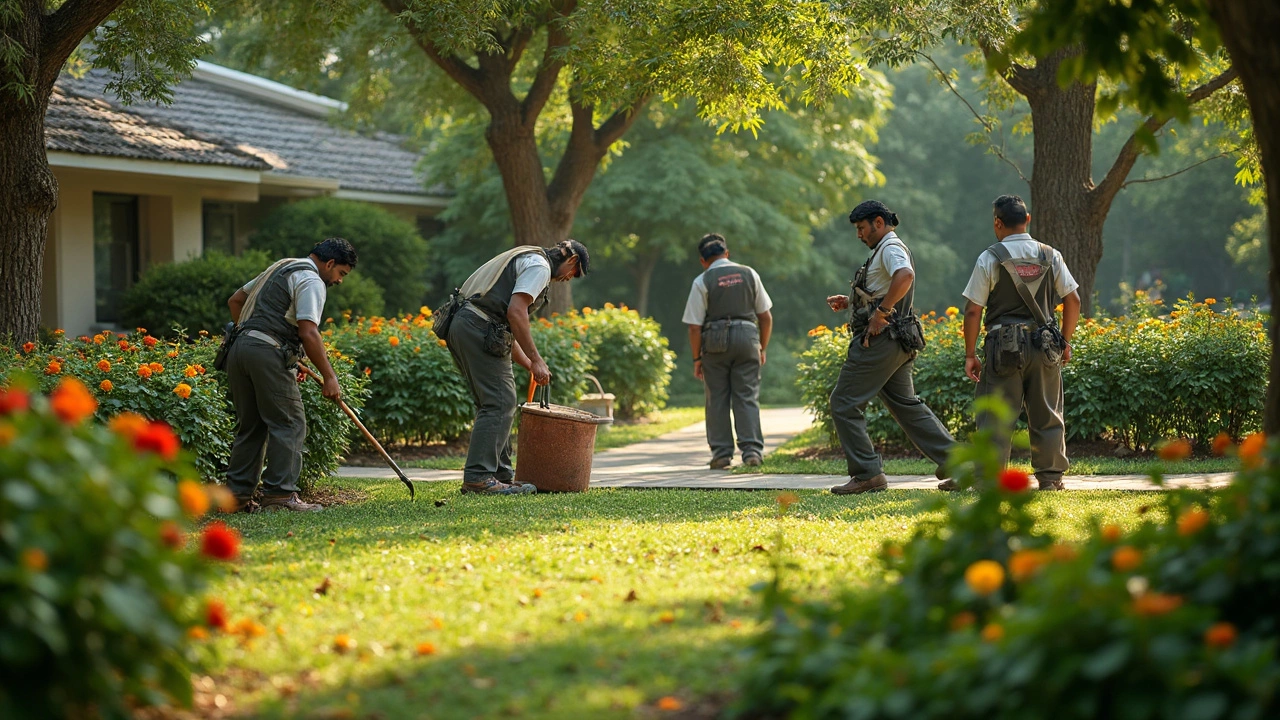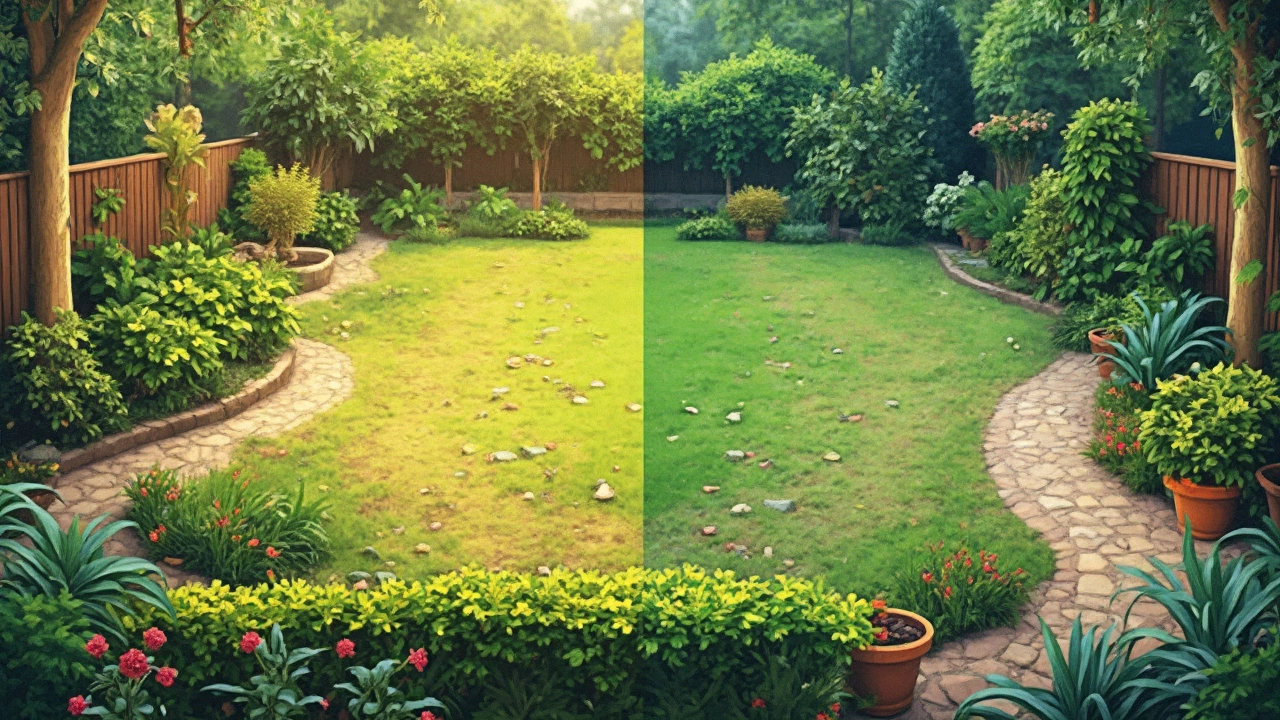Ever wondered what yard work actually covers? It’s not just mowing the grass and calling it a day. There’s a whole playbook of tasks that go into keeping a yard tidy, healthy, and ready for summer BBQs—or surviving the fall leaf dump. At its core, yard work is about keeping all outdoor areas around your house looking good and thriving. That means taking care of everything: your lawn, flower beds, shrubs, and even that random patch behind the shed.
Here’s one thing people often miss: yard work is about both looks and health. Sure, a tidy yard makes you look like you’ve got it together (my neighbor always comments after a big clean-up day), but it also keeps your grass, plants, and trees fighting fit. Skipping tasks like trimming, or even forgetting to rake up leaves, can invite bugs or kill off patches of grass way faster than you’d expect. So if you want your yard to be the envy of the block—or just want to keep Bailey from bringing in more mud than usual—you’ll want to know what’s actually involved.
- Mowing, Edging, and Lawn Care
- Trimming, Pruning, and Shrub Maintenance
- Garden Bed Upkeep and Weeding
- Leaf and Debris Cleanup
- Extras: Mulching, Fertilizing, and Beyond
Mowing, Edging, and Lawn Care
Mowing doesn’t just make your lawn look neat—it actually helps it stay healthy. Cutting grass regularly helps roots grow deeper and snuffs out weeds before they can take over. Aim for the one-third rule: never chop off more than a third of the blade in one go. That keeps the grass from getting stressed out, especially during summer heat.
Don’t forget the edges. Edging your lawn where it meets sidewalks, driveways, and flower beds gives it a crisp look, kind of like cleaning up the neckline after a haircut. Grass overgrowth on walkways is a common eyesore, and a quick run with an edger solves it—no extra skill required, just a steady hand. Along fence lines or garden beds, string trimmers or manual lawn clippers work best.
Lawn care goes further than mowing and edging, though. Think about watering (early mornings are best—less evaporation), feeding with the right fertilizer, and watching for brown patches that could mean pests or poor soil. Dogs like Bailey can add to the mix: dog urine can leave spots. Watering those areas right after does help dilute the problem.
If you want to see how much these care steps affect your lawn, take a quick look at the average stats for a healthy spring lawn:
| Lawn Task | Average Frequency | Why It Matters |
|---|---|---|
| Mowing | Once per week (spring/summer) | Keeps grass healthy, stops weeds |
| Edging/Trimming | Every 2-3 weeks | Neat lines, stops grass spreading |
| Watering | 1-2 inches weekly | Helps roots grow deep |
| Fertilizing | 2-4 times per year | Feeds and strengthens grass |
So, if you’re aiming to really keep your yard work dialed in, don’t just mow and walk away. Throw in regular edging and stick to a simple watering and feeding plan. You’ll spot the difference quick, especially when those random weeds finally give up the fight. Plus, Bailey’s post-fetch zoomies won’t destroy the place quite as fast.
Trimming, Pruning, and Shrub Maintenance
When people talk about yard work, trimming and pruning are right up there on the to-do list. This isn’t just about making things look neat. It actually keeps your plants and bushes healthier, less prone to pests, and looking their best year-round.
Let’s break down what this covers:
- Trimming: Cutting back fast-growing hedges, shrubs, or ground covers to keep lines crisp and plants from going wild. Most folks do this a couple of times each growing season, but it depends on how fast your greenery grows.
- Pruning: This is more about removing specific branches or stems to boost plant health or shape. Pruning stops disease from spreading and encourages new growth. For a lot of shrubs, late winter or early spring is best, but some flowering bushes need it right after they bloom. Check the tag that comes with your plant or look up its name to get the timing right.
- Shrub maintenance: It’s everything else—watering, checking for bugs, and making sure mulched beds don’t get crusty or overgrown. Mulch also slows weeds, keeps roots cool, and keeps moisture in the soil a little longer, so you’re not out there every day with the hose.
Here’s something most people don’t realize: if you cut too much, or slice at the wrong spot, you can hurt certain plants. Use sharp, clean tools (disinfect them if you’re moving from a sick plant to a healthy one) and pay attention to where new growth appears. Also, never prune more than a third of a shrub at a time—that keeps shock and die-back to a minimum.
Why bother with all this? A little attention goes a long way. Check out this table showing how often you should tackle trimming and pruning for the most common yard plants:
| Type of Plant | Trimming Frequency | Pruning Time |
|---|---|---|
| Evergreen Shrubs | 2-3 times/year | Late Spring |
| Deciduous Shrubs | 1-2 times/year | Late Winter/Early Spring |
| Flowering Shrubs | After blooms fade | Right after flowering |
| Hedges | Every 6 weeks (growing season) | End of winter |
If you’re not sure what’s growing in your yard, snap a picture and ask at a local garden center—they’ll usually know exactly what you need. Remember, a tidy yard doesn’t just look good, it actually lasts longer and stays healthier with some basic cutting and care.

Garden Bed Upkeep and Weeding
Garden beds are where your yard’s personality really shows—and they’re also magnets for weeds and mess if you’re not careful. A big part of yard work means staying on top of these beds so your flowers and shrubs get the best shot at growing strong without competition from unwanted plants.
Weeding isn’t a one-and-done deal. You really have to stay at it because many weeds can come back in less than a week—especially after rain. Regular checks make a huge difference. Just 15-20 minutes a week pulls most weeds before they flower or set seed. If you leave them, they can choke out your good plants, spread fast, and even attract pests.
Besides yanking weeds, garden bed upkeep includes things like fluffing up the soil so roots get more air and water, cutting off dead flower heads (called deadheading), and making sure mulch is spread out evenly to keep the ground cool and moist. Mulching is the secret weapon: a 2-3 inch layer blocks sunlight to the weeds but helps the plants you want to keep. If you’re planting new stuff, space everything out so air flows and you don’t get mold or mildew.
- Hand-pulling or hoeing weeds is most effective for beds with delicate plants.
- If you use weed killer, stick to ones made for gardens so you don't nuke your flowers.
- Don’t forget about edging—clean edges stop grass from creeping in and keep beds looking sharp.
- After storms, re-tuck mulch and check for signs of root rot or mold.
To give you an idea how much time folks typically spend, check out this breakdown:
| Task | Time Per 200 sq ft (Avg) |
|---|---|
| Weeding | 20 min/week |
| Spreading Mulch | 45 min (spring/fall) |
| Deadheading/Pruning | 15 min/week |
Stay ahead on these jobs, and your garden beds will turn from weedy mess to the envy of the block—and way less work later in the season.
Leaf and Debris Cleanup
If you’ve ever left leaves sitting on your lawn, you probably realized fast that it’s not just about looks. Piles of dead leaves and yard junk can block water and sunlight, smother your grass, and even lead to mold. In fact, thick piles can raise the risk of fungal diseases—which nobody wants to deal with in the spring. The EPA estimates that yard trimmings and leaves made up over 35 million tons of waste in the US in 2023, so you’re definitely not alone dealing with this mess.
Leaf and debris cleanup goes way past raking once or twice in the fall. It covers leaves, branches from storms, fallen fruit, seed pods, trash that blows in from the street, and even pet droppings that can build up out back. Regular pickups can help you avoid slippery walkways, bug issues, clogged gutters, and yard damage. If you really want to protect your yard work investment, plan on doing these cleanups at least a few times a year—or every week during the heavy fall drop.
- Start with a rake or a leaf blower. Use the blower for quick jobs and the rake for stubborn, wet leaves.
- Gather everything onto a tarp or into piles. Makes it so much easier to bag or compost later—don’t try hauling with your hands unless you want a mess everywhere.
- Bag up for pickup, or start your own compost. Most towns offer leaf pickup but check your schedule. Composting helps you recycle nutrients right back to your garden beds.
- Don’t forget gutters and corners. Leaves love sneaking into places you barely look at. Blocked gutters can lead to basement leaks or rot.
Some people use mulching mowers or leaf mulchers, which chop up dead leaves so they feed the lawn instead of cluttering it—think of it as free fertilizer. Timing matters, too; windless days make cleanup way less frustrating (I’ve chased piles around for hours when the wind kicked up).
| Yard Debris | How Often to Clean | Best Tool |
|---|---|---|
| Leaves | Weekly during fall | Leaf blower or rake |
| Twigs/Branches | After storms, monthly | Loppers, saw, gloves |
| Trash/Litter | Weekly | Gloves, trash bag |
| Gutters | Twice a year | Gloves, small scoop |
Bottom line? Stay on top of leaf and debris cleanups if you want a yard that looks good and doesn't hide surprises. Skipping these jobs can make you spend more time and money fixing damage down the line, and nobody wants that, trust me—especially after seeing muddy paw prints from Bailey all over the living room.

Extras: Mulching, Fertilizing, and Beyond
A lot of people stop at mowing and trimming, but if you want a healthy, great-looking yard, the real game changers are mulching, fertilizing, and a couple more extras. These jobs might not look as dramatic as a fresh trim, but they make a huge difference over the long run.
Let’s talk yard work that actually pays off. Mulching adds a barrier on top of your soil. Not only does it keep weeds down, it also helps the dirt hold water—which means less time dragging hoses around all summer. A study by the University of Georgia found that mulched garden beds retain about 25% more moisture than bare dirt. That’s a serious water saver.
Fertilizing is all about feeding your grass and plants the nutrients they lose over time. Most lawns need to be fed about 2-4 times a year, depending on your grass type and local climate. Skipping fertilizer leaves your yard looking dull and patchy, no matter how much you mow.
- How to mulch: Pile 2-3 inches of mulch around plants. Don’t let it touch the stems or tree trunks—this helps avoid rot.
- When to fertilize: Early spring and late summer are the best times for most grasses, but always check your specific lawn type. The bag tells all.
- Other extras: Aeration (poking holes in the soil) lets air and water reach roots better. If your lawn looks tired, aerating once a year can perk it right up. Dethatching—removing the thick dead layer of grass—helps new grass push through.
Here’s a quick look at how some of these extras help:
| Task | Main Benefit | How Often |
|---|---|---|
| Mulching | Prevents weeds, holds moisture | Once or twice a year |
| Fertilizing | Feeds grass/plants | 2-4 times per year |
| Aeration | Improves soil, root growth | Once a year |
| Dethatching | Removes dead grass layer | Every 1-2 years |
If you go the extra mile with these steps, you’ll notice the difference. Less mud, thicker grass, and fewer weeds to yank out on Sunday mornings. Your dog might even keep their paws cleaner—mine does, anyway.
